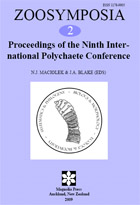Abstract
Pectinaria gouldii and Phragmatopoma lapidosa are marine polychaetes that reside in protective structures built from sand grains bound together using proteinaceous cement secreted from specialized glands. P. gouldii constructs a solitary, ice-cream-cone-like structure. The smaller, gregarious P. lapidosa forms a large, reef-like mound. This study investigates the physical features of these two polychaete biocements, linking structure and function in two marine environments.
The surface structures of hydrated biocement samples were analyzed using atomic force microscopy (AFM), and the surface structures and composition of dehydrated biocement samples were analyzed using scanning electron microscopy (SEM) and electron dispersive spectroscopy (EDS). Atomic force analyses indicate that (in their native states) the surface roughness, adhesion, and stiffness of P. gouldii biocement are greater than P. lapidosa biocement. The surface of P. gouldii resembled “cottage cheese,” while the surface of P. lapidosa had smoother features. SEM revealed “popped bubble” features that indicated a solid foam-like material for both biocements. EDS confirmed the presence of calcium, magnesium, and phosphorous in both biocements, with varying amounts of these three elements at different locations on the same sample.

